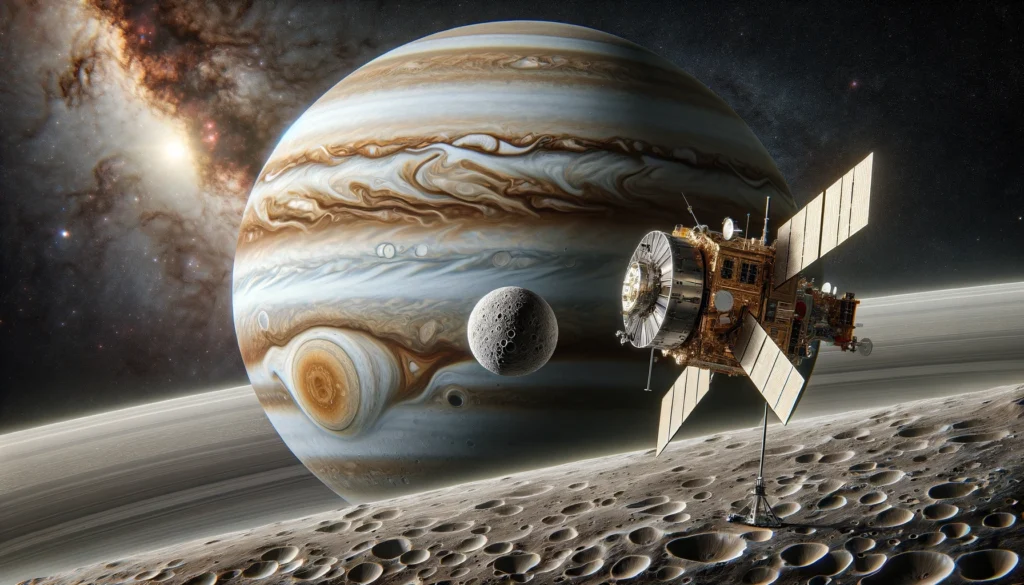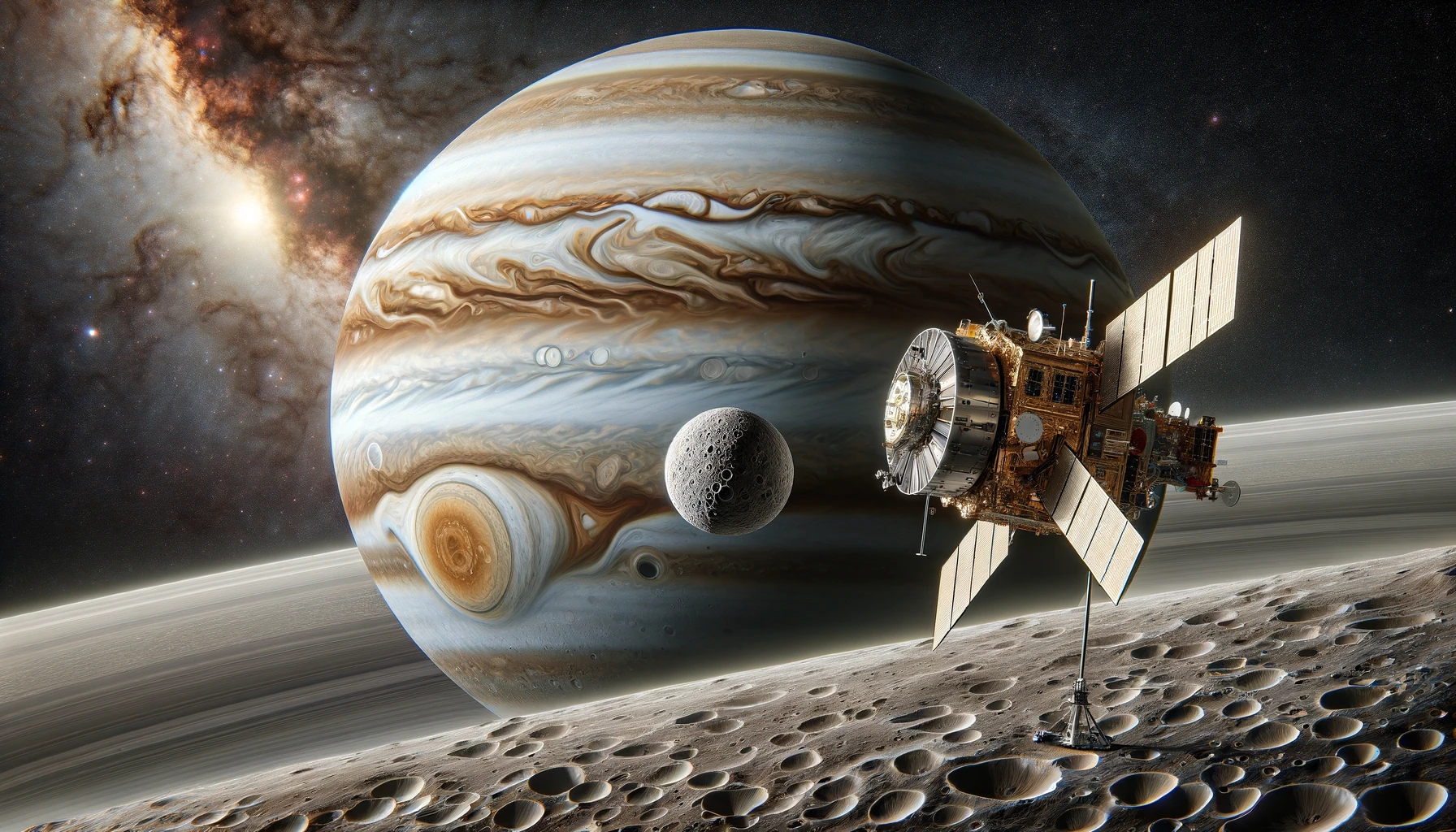NASA Juno mission, Jupiter, Amalthea, Jupiter’s moons, JunoCam, Great Red Spot, space exploration, Gerald Eichstädt, citizen science, Jovian system, Jupiter flyby, NASA spacecraft, Jupiter’s atmosphere, Amalthea thermal properties
Discover the latest breathtaking images from NASA’s Juno mission showcasing Jupiter’s vibrant atmosphere and the tiny moon Amalthea. Learn about the unique characteristics of Amalthea, its orbit, and the collaborative efforts of citizen scientists in processing these stunning visuals.

NASA’s Juno mission has once again provided breathtaking views of Jupiter and its intricate system. On March 7, 2024, during its 59th close flyby of the gas giant, Juno captured stunning images that not only highlight Jupiter’s iconic features but also offer glimpses of one of its smallest moons, Amalthea.
A Closer Look at Jupiter
Jupiter, the largest planet in our solar system, is known for its vibrant belts and tumultuous storms. The images from Juno’s recent flyby showcase these features in striking detail. The planet’s atmosphere is a tapestry of colors and patterns, dominated by its alternating bands of clouds and the swirling storms that punctuate these belts. Among these storms is the Great Red Spot, a colossal, persistent high-pressure region that has been raging for centuries. This iconic feature, larger than Earth itself, is vividly captured in the latest images from Juno.
Introducing Amalthea
Amidst the grandeur of Jupiter’s atmosphere, a keen observer might notice a small, irregularly shaped object: Amalthea. This tiny moon, with a radius of just 52 miles (84 kilometers), is one of Jupiter’s many satellites. Unlike the planet’s larger, more spherical moons, Amalthea’s shape is distinctly potato-like, a result of its insufficient mass to form a perfect sphere.
Physical Characteristics and Orbit
Amalthea’s irregular shape and surface features were first detailed by NASA’s Galileo spacecraft in 2000. The moon’s surface is marked by impact craters, hills, and valleys, hinting at a tumultuous history of collisions and geological activity. Amalthea orbits Jupiter at a distance closer than Io, the innermost of Jupiter’s four largest moons, completing a single orbit in just under half an Earth day (0.498 Earth days).
Unique Thermal Properties
One of Amalthea’s most intriguing characteristics is its thermal emission. It is the reddest object in the solar system and emits more heat than it receives from the Sun. This phenomenon is likely due to its interaction with Jupiter’s powerful magnetic field, which induces electric currents in the moon’s core, generating heat. Another possible source of this heat is the tidal stresses caused by Jupiter’s immense gravitational pull, which could cause internal friction and subsequent warming.
The Significance of Juno’s Observations
The images of Amalthea captured by Juno are significant for several reasons. Firstly, they provide an opportunity to study the moon’s surface and thermal properties in greater detail. This can offer insights into its composition and the dynamic processes at play within and around it. Secondly, observing Amalthea in the context of Jupiter’s environment helps scientists understand how smaller celestial bodies interact with their parent planets, especially in terms of magnetic and gravitational influences.
JunoCam and Image Processing
The images of Jupiter and Amalthea were captured using the JunoCam instrument aboard the Juno spacecraft. JunoCam is a visible light camera designed to capture the planet’s atmosphere and its moons. The raw data from JunoCam are available to the public, and citizen scientist Gerald Eichstädt played a crucial role in processing these latest images. Eichstädt applied advanced techniques to enhance the clarity and detail of the images, allowing for a more precise examination of Jupiter’s atmospheric features and Amalthea’s presence.
The Role of Citizen Scientists
The involvement of citizen scientists like Gerald Eichstädt underscores the collaborative nature of modern space exploration. By making raw data accessible to the public, NASA encourages enthusiasts and experts alike to contribute to the analysis and interpretation of these data. This approach not only expands the pool of knowledge and expertise applied to the data but also fosters a sense of community and shared purpose among those passionate about space exploration.
Looking Ahead: Future Missions and Discoveries
The Juno mission, launched in 2011, has been a monumental success in advancing our understanding of Jupiter. Initially planned for a shorter duration, the mission has been extended to continue its valuable scientific work. Each flyby provides new data, revealing more about the gas giant’s composition, magnetic field, atmosphere, and its moons.
Continued Exploration of Jupiter’s Moons
While Amalthea is one of the smaller and less studied of Jupiter’s moons, it represents an important piece of the puzzle in understanding the Jovian system. Future missions may focus more on Jupiter’s larger moons, such as Europa, Ganymede, and Callisto, which are of great interest due to their potential for harboring subsurface oceans and, possibly, life. However, smaller moons like Amalthea offer unique opportunities to study the effects of Jupiter’s magnetic field and the dynamics of its inner moon system.
The Legacy of Juno
As Juno continues its mission, the data it collects will be invaluable for both current and future research. The spacecraft’s observations are not only enhancing our knowledge of Jupiter but are also providing a framework for understanding other gas giants in our solar system and beyond. The mission’s success demonstrates the importance of sustained exploration and the potential for unexpected discoveries.
Conclusion
NASA’s Juno mission has once again captivated the world with its latest images of Jupiter and its tiny moon Amalthea. These observations not only highlight the beauty and complexity of Jupiter’s atmosphere but also offer valuable insights into the characteristics and behaviors of its moons. Through the efforts of both NASA scientists and dedicated citizen scientists, we continue to unravel the mysteries of our solar system, one stunning image at a time. As Juno continues its journey, we can look forward to even more groundbreaking discoveries that will expand our understanding of the cosmos.
Read More-
